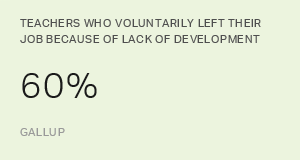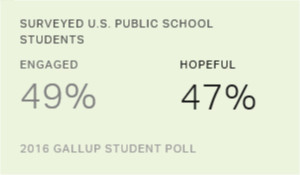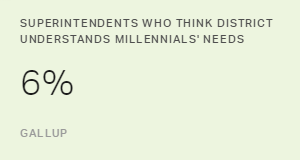Will the talented teachers in your district extend their contracts for another year?
The chances are good that your high-talent teachers are on the lookout for other job opportunities. Gallup's research shows that almost half of teachers (48%) in the U.S. say they are actively looking for a different job now or watching for opportunities. At the beginning of the 2017-18 school year, almost every U.S. state had shortages of teachers in major subject areas.
According to the Learning Policy Institute, the economics of the teacher shortage are somewhat clear. The demand for teachers is growing because of stricter requirements on teacher-to-student ratios and increasing student enrollment in public schools. Meanwhile, teacher supply is diminishing because fewer people are enrolling in teacher preparation programs in college and current teachers are leaving the profession.
These market forces and the growing national teacher shortages are challenging district leaders to rethink and focus on their human capital strategies. Some states have turned to drastic measures to fill these educator roles by hiring college graduates without a teacher certification or formal teaching experience.
However, within these dramatic headlines and statistics, variability exists, and some districts are thriving despite these macroeconomic forces. Some districts have candidate-to-hire ratios at 20:1, while others are 2:1 -- a coin flip to see which candidate a district will place in the classroom.
Why Teachers Leave
Gallup recently asked teachers to recall the primary reason they left their last job and categorized their responses. We found that 29% of teachers left for personal reasons such as relocation or health reasons.
Of the remaining teachers who left for job-related reasons, 16% were terminated involuntarily and 84% left voluntarily. The reasons employees cited for leaving voluntarily are particularly insightful, as they might reflect more actionable school-level factors.
By a large margin, the primary reason teachers gave for leaving their last job was career advancement or development, with 60% of teachers who left voluntarily citing reasons related to this category.
This percentage shows that many teachers might not have felt challenged in their work or received individualized opportunities to grow and advance, so they left their job. Even though many districts invest heavily in professional development programs, these opportunities might not be individualized to teachers' specific growth and development needs.
Pay or benefits was the next most cited reason for leaving, with 13% of teachers who left voluntarily mentioning this reason. Low pay, especially early in an educator's career, could stifle the attractiveness of the profession, especially for individuals carrying large student debt burdens.
Despite a prevailing focus on low teacher pay, teachers actually mentioned their pay as the reason they left their last job at a lower rate compared with other workers. One in four (24%) non-teachers voluntarily left their last job because of pay.
Turnover can cost an organization anywhere from one-half to five times the employee's salary. The variability in this number is the result of the difficulty in measuring both hard costs, such as advertising and training, as well as some of the unseen costs, such as the impact on team morale and student relationships.
How to Keep Your Best Teachers
Considering the costs of replacing teachers, and with fewer teachers in the available candidate pool and more open teaching positions, districts must work to differentiate their employee value proposition to attract, recruit, develop and retain talented teachers.
District leaders can start by focusing on four approaches to attract and retain top teacher talent in the face of a seemingly systemic teacher shortage.
1. Know who is in your candidate pool.
Labor market data would contend that there will continue to be fewer qualified teaching candidates available in the pool in the years to come. Thus, to win qualified candidates, district leaders need to better understand the type of talent they are competing for. The vast majority of new teachers entering the profession are millennials.
According to Gallup's How Millennials Want to Work and Live report, millennial job seekers are most attracted to workplaces that provide opportunities to learn and grow. Still, 48% of millennials say that overall compensation is extremely important to them when seeking new job opportunities. Millennial teachers want both a paycheck and a purpose-driven career. District leaders should ensure their employee proposition to millennials seeking teaching positions reflects this generation's needs of individualized growth and development.
2. Engineer an exit survey program to better understand your district's challenges.
Just as critical as understanding who is coming into the district is understanding who is leaving the district and why.
Teachers leaving a district is nothing new. However, given the high stakes of the teacher shortage, smart district leaders are looking for more insights into why their teachers are resigning. They want to understand the reasons for the departure and gain in-depth insights into how to retain their best. As a response, many school districts are focusing more on exit survey programs.
An effective exit process enables a district to not only reduce turnover, but also improve incumbent teacher engagement. For example, discovering that teachers who are leaving feel unappreciated provides an opportunity to emphasize workplace recognition and, in turn, increase teacher engagement.
3. Maximize your data through predictive turnover analytics.
Exit data are valuable, but forward-thinking leaders don't stop there -- they get ahead of turnover by predicting it before it happens. Predictive turnover analytics could help uncover risk factors for turnover, which would allow leaders to anticipate and mitigate problems before teachers leave.
District personnel should conduct predictive turnover analyses using employee engagement data, performance data, demographics, principal/parent metrics and information about school- and team-level environments. Additionally, pairing teacher survey, performance and employment data with information about intention to stay or leave the district can be a powerful, data-driven exercise that alleviates teacher departures.
4. Engage your top talent to stop them from leaving your district.
Of the four approaches, district leaders likely have the most control over this one.
Teaching is a challenging but rewarding career. According to recent Gallup data, only 34% of teachers are engaged in their job. Further, Gallup analytics show that 46% of K-12 teachers report high daily stress during the school year.
However, Gallup also finds that when talented, high-performing employees are not engaged in their job, they are just as likely as disengaged, low performers to quit their job. To engage teachers, leaders must provide a path for them to follow to boost their development, have creativity and autonomy in the classroom, and create a thriving learning environment for students. District leaders should measure teacher engagement in their district and encourage school-level conversations and action planning to improve engagement and teacher retention.
In the war for highly talented teachers, retention is the best defensive strategy a district can use. If you are not engaging and developing your teachers, they will find another district or profession that will.
Check out a few resources to help you hire and keep the best teachers:
- Watch our webinar "Creating Thriving Schools During a Teacher Shortage."
- Read case studies from a few of Gallup's clients that retain and engage great teachers.
- Browse Gallup's solutions for K-12 educators who want to build engaging and thriving schools.



